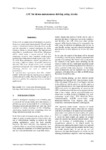A3C for drone autonomous driving using Airsim

Use este enlace para citar
http://hdl.handle.net/2183/28307
Excepto si se señala otra cosa, la licencia del ítem se describe como Atribución-NoComercial-CompartirIgual 4.0 Internacional
https://creativecommons.org/licenses/by-nc-sa/4.0/deed.es
Colecciones
Metadatos
Mostrar el registro completo del ítemTítulo
A3C for drone autonomous driving using AirsimFecha
2021Cita bibliográfica
Villota, D., Gil,. M., Rico, J. A3C for drone autonomous driving using Airsim. En XLII Jornadas de Automática: libro de actas. Castelló, 1-3 de septiembre de 2021 (pp. 203-209). DOI capítulo: https://doi.org/10.17979/spudc.9788497498043.203 DOI libro: https://doi.org/10.17979/spudc.9788497498043
Resumen
[Abstract] In this work, we apply artificial intelligence to guide a drone to a certain point autonomously. Unreal engine creates a virtual environment where the drone can fly, and the algorithm is trained simulating the drone dynamics thanks to Airsim plugin. The implemented algorithm is Asynchronous Actor-Critic Advantage (A3C), which trains a neural network with less computing resources than standard reinforcement learning algorithms that normally needs costly GPUs. To prove these advantages, several experiments are run using a different number of parallel simulations (threads). The drone should reach a point randomly generated each episode. The reward, the value and the advantage function are used to evaluate the performance. As expected, these experiments show that a higher number of threads helps the leaning process improve and become more stable. These learning results are of interest to optimize the computing resources in future applications.
Palabras clave
A3C
Actor critic
Reinforcement learning
Autonomous driving
Airsim
Multithread
Actor critic
Reinforcement learning
Autonomous driving
Airsim
Multithread
Versión del editor
Derechos
Atribución-NoComercial-CompartirIgual 4.0 Internacional
https://creativecommons.org/licenses/by-nc-sa/4.0/deed.es
ISBN
978-84-9749-804-3






